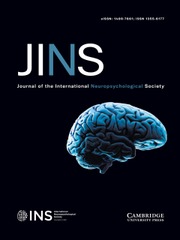Crossref Citations
This article has been cited by the following publications. This list is generated based on data provided by
Crossref.
Li, Fengfang
Lu, Liyan
Chen, Huiyou
Wang, Peng
Chen, Yu-Chen
Zhang, Hong
and
Yin, Xindao
2019.
Disrupted brain functional hub and causal connectivity in acute mild traumatic brain injury.
Aging,
Vol. 11,
Issue. 22,
p.
10684.
Harper, Matthew M.
Woll, Addison W.
Evans, Lucy P.
Delcau, Michael
Akurathi, Abhigna
Hedberg-Buenz, Adam
Soukup, Dana A.
Boehme, Nickolas
Hefti, Marco M.
Dutca, Laura M.
Anderson, Michael G.
and
Bassuk, Alexander G.
2019.
Blast Preconditioning Protects Retinal Ganglion Cells and Reveals Targets for Prevention of Neurodegeneration Following Blast-Mediated Traumatic Brian Injury.
Investigative Opthalmology & Visual Science,
Vol. 60,
Issue. 13,
p.
4159.
Park, Eugene
McCutcheon, Victoria
Telliyan, Tamar
Liu, Elaine
Eisen, Rebecca
Kinio, Anna
Tavakkoli, Jahan
and
Baker, Andrew J
2020.
Remote ischemic conditioning improves outcome independent of anesthetic effects following shockwave-induced traumatic brain injury.
IBRO Reports,
Vol. 8,
Issue. ,
p.
18.
Sheth, Chandni
Prescot, Andrew P.
Legarreta, Margaret
Renshaw, Perry F.
McGlade, Erin
and
Yurgelun-Todd, Deborah
2020.
Increased myoinositol in the anterior cingulate cortex of veterans with a history of traumatic brain injury: a proton magnetic resonance spectroscopy study.
Journal of Neurophysiology,
Vol. 123,
Issue. 5,
p.
1619.
Stone, James R.
Avants, Brian B.
Tustison, Nicholas J.
Wassermann, Eric M.
Gill, Jessica
Polejaeva, Elena
Dell, Kristine C.
Carr, Walter
Yarnell, Angela M.
LoPresti, Matthew L.
Walker, Peter
O'Brien, Meghan
Domeisen, Natalie
Quick, Alycia
Modica, Claire M.
Hughes, John D.
Haran, Francis. J.
Goforth, Carl
and
Ahlers, Stephen T.
2020.
Functional and Structural Neuroimaging Correlates of Repetitive Low-Level Blast Exposure in Career Breachers.
Journal of Neurotrauma,
Vol. 37,
Issue. 23,
p.
2468.
Li, Fengfang
Lu, Liyan
Shang, Song'an
Hu, Lanyue
Chen, Huiyou
Wang, Peng
Zhang, Hong
Chen, Yu‐Chen
and
Yin, Xindao
2020.
Disrupted functional network connectivity predicts cognitive impairment after acute mild traumatic brain injury.
CNS Neuroscience & Therapeutics,
Vol. 26,
Issue. 10,
p.
1083.
Peitz, Geoffrey W.
Wilde, Elisabeth A.
and
Grandhi, Ramesh
2021.
Magnetoencephalography in the Detection and Characterization of Brain Abnormalities Associated with Traumatic Brain Injury: A Comprehensive Review.
Medical Sciences,
Vol. 9,
Issue. 1,
p.
7.
Baskin, Britahny
Lee, Suhjung Janet
Skillen, Emma
Wong, Katrina
Rau, Holly
Hendrickson, Rebecca C.
Pagulayan, Kathleen
Raskind, Murray A.
Peskind, Elaine R.
Phillips, Paul E. M.
Cook, David G.
and
Schindler, Abigail G.
2021.
Repetitive Blast Exposure Increases Appetitive Motivation and Behavioral Inflexibility in Male Mice.
Frontiers in Behavioral Neuroscience,
Vol. 15,
Issue. ,
Hergert, Danielle C.
Robertson-Benta, Cidney
Sicard, Veronik
Schwotzer, Daniela
Hutchison, Kent
Covey, Dan P.
Quinn, Davin K.
Sadek, Joseph R.
McDonald, Jacob
and
Mayer, Andrew R.
2021.
Use of Medical Cannabis to Treat Traumatic Brain Injury.
Journal of Neurotrauma,
Vol. 38,
Issue. 14,
p.
1904.
Mohamed, Abdalla Z.
Cumming, Paul
and
Nasrallah, Fatima A.
2021.
Traumatic brain injury augurs ill for prolonged deficits in the brain’s structural and functional integrity following controlled cortical impact injury.
Scientific Reports,
Vol. 11,
Issue. 1,
Lunkova, Ekaterina
Guberman, Guido I.
Ptito, Alain
and
Saluja, Rajeet Singh
2021.
Noninvasive magnetic resonance imaging techniques in mild traumatic brain injury research and diagnosis.
Human Brain Mapping,
Vol. 42,
Issue. 16,
p.
5477.
Vartanian, Oshin
Coady, Lori
Blackler, Kristen
Fraser, Brenda
and
Cheung, Bob
2021.
Neuropsychological, Neurocognitive, Vestibular, and Neuroimaging Correlates of Exposure to Repetitive Low-Level Blast Waves: Evidence From Four Nonoverlapping Samples of Canadian Breachers.
Military Medicine,
Vol. 186,
Issue. 3-4,
p.
e393.
Otero, Marcela C.
Rau, Holly K.
Shofer, Jane B.
Peskind, Elaine R.
and
Pagulayan, Kathleen F.
2022.
Self-perceived irritability among OEF/OIF/OND veterans with a history of deployment-related mTBI: Associations with prospective memory and quality of life.
The Clinical Neuropsychologist,
Vol. 36,
Issue. 6,
p.
1384.
Healey, Katherine
Fang, Zhuo
Smith, Andra
Zemek, Roger
and
Ledoux, Andrée-Anne
2022.
Adolescents with a concussion have altered brain network functional connectivity one month following injury when compared to adolescents with orthopedic injuries.
NeuroImage: Clinical,
Vol. 36,
Issue. ,
p.
103211.
Holmes, Scott A.
2022.
Biomarkers in Trauma, Injury and Critical Care.
p.
1.
Healey, Katherine
Fang, Zhuo
Smith, Andra
Zemek, Roger
and
Ledoux, Andrée-Anne
2022.
Altered Brain Network Functional Connectivity One Month Following Pediatric Concussion.
SSRN Electronic Journal ,
Holmes, Scott A.
2023.
Biomarkers in Trauma, Injury and Critical Care.
p.
59.
Liu, Hongkun
Zhang, Gengbiao
Zheng, Hongyi
Tan, Hui
Zhuang, Jiayan
Li, Weijia
Wu, Bixia
and
Zheng, Wenbin
2023.
Dynamic Dysregulation of the Triple Network of the Brain in Mild Traumatic Brain Injury and Its Relationship With Cognitive Performance.
Journal of Neurotrauma,
Kim, Sharon Y.
Yeh, Ping-Hong
Ollinger, John M.
Morris, Herman D.
Hood, Maureen N.
Ho, Vincent B.
and
Choi, Kwang H.
2023.
Military-related mild traumatic brain injury: clinical characteristics, advanced neuroimaging, and molecular mechanisms.
Translational Psychiatry,
Vol. 13,
Issue. 1,




